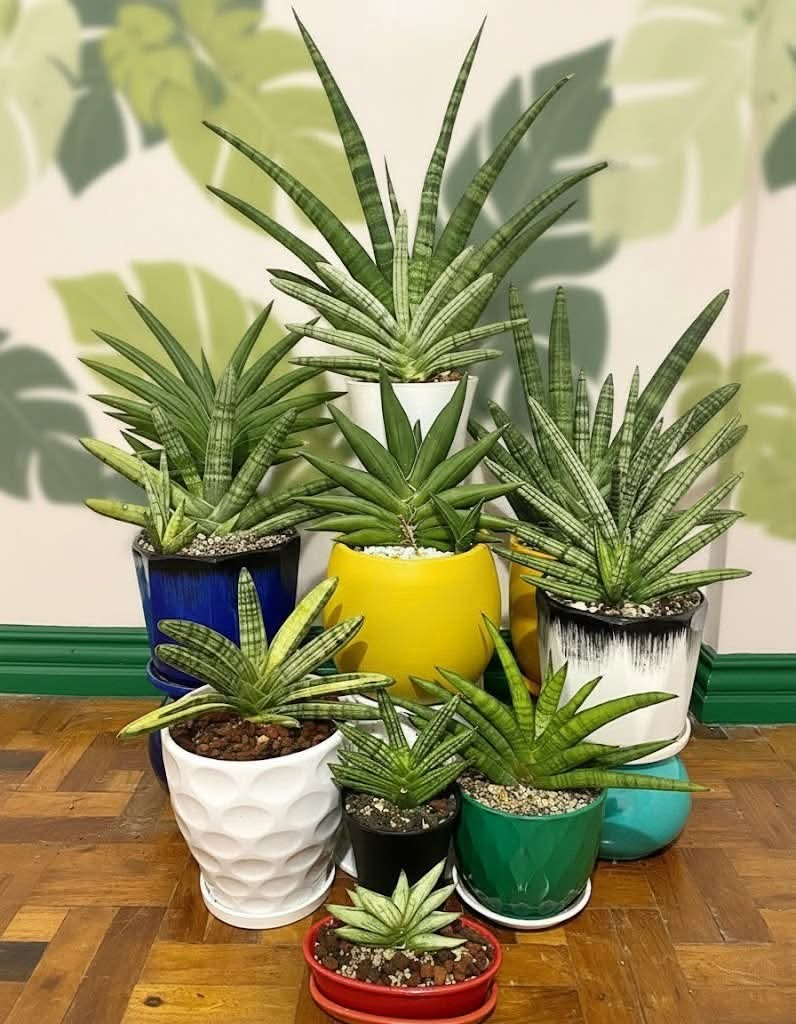This Sansevieria Collection Grows Beautifully With Minimal Care—Here’s How to Grow Yours
Sansevieria, often called Snake Plant or Mother-in-Law’s Tongue, is one of the most low-maintenance indoor plants you can grow. What makes collections like the one above so impressive is that Sansevieria varieties are extremely resilient, drought-tolerant, and adaptable to almost any home environment. With the right care, they multiply quickly, remain strikingly upright, and provide excellent indoor air purification—making them a top choice in indoor gardening, home improvement, and low-maintenance plant care content.
Why Sansevieria Is Perfect for Beginners and Collectors
Sansevierias are popular because they:
- Thrive in low, medium, or bright indirect light
- Tolerate missed waterings
- Grow well in small or large containers
- Resist pests better than most houseplants
- Improve indoor air quality by absorbing toxins
These characteristics make them ideal for people who want low-maintenance indoor plants that still look stylish and modern.
How to Grow a Healthy and Fast-Multiplying Sansevieria Collection
1. Give Them the Right Light
Sansevieria can tolerate low light, but they grow fastest in:
- Bright, indirect light
- Filtered morning sun
- Avoid intense mid-afternoon sun (can scorch leaves)
Proper lighting enhances leaf color and encourages new offsets—key points often highlighted in indoor plant care and succulent growth tips.
2. Use the Ideal Soil Mix
The secret to bold, upright growth is a fast-draining soil blend. Use:
- 50% cactus or succulent mix
- 25% perlite or pumice
- 25% orchid bark or coarse sand
This prevents root rot and keeps oxygen flowing to the roots, a major advantage for container gardening and drought-tolerant plants.
3. Water the Right Way
Sansevieria prefers to stay dry rather than wet.
Water only when:
- The top 2–3 inches of soil are completely dry
- The pot feels noticeably lighter
General watering schedule:
- Every 2–3 weeks in spring and summer
- Every 4–5 weeks in winter
Overwatering is the number one cause of problems, making proper hydration an essential topic in succulent care guides and organic gardening tips.
4. Choose the Best Pots for Growth
Sansevieria grows tighter and faster when slightly root-bound. Use:
- Pots with drainage holes
- Terra cotta or ceramic containers
- Shallow but wide pots for clustering varieties
This helps create compact, symmetrical shapes like the ones in beautiful home décor and indoor plant styling photos.
5. Fertilize for Bigger, Faster Growth
Feed lightly during the growing season:
- Use a balanced liquid fertilizer (10-10-10 or 5-5-5)
- Apply once every 4–6 weeks
- Avoid fertilizing in winter
This boosts leaf production and strengthens roots, aligning with plant growth booster methods known to increase performance.
6. Propagate to Expand Your Collection
Sansevierias multiply easily through:
- Division of pups
- Leaf cuttings in soil
- Leaf cuttings in water (slower but effective)
Propagation is a top-searched sustainable home hack, perfect for expanding your collection for free.
7. Keep Pests and Problems Away
Sansevieria rarely attracts pests, but watch for:
- Mealybugs
- Spider mites
- Fungus gnats (if soil stays wet)
Fix issues by improving drainage and reducing moisture. A major benefit for people searching for low-maintenance indoor plants.
Popular Sansevieria Varieties to Add to Your Collection
Some stunning types that grow well with the same care include:
- Sansevieria cylindrica
- Sansevieria laurentii
- Sansevieria hahnii
- Sansevieria masoniana
- Sansevieria moonshine
Each variety adds shape and texture, making your indoor garden more visually dynamic—ideal for home improvement and interior décor content.
Final Tips for a Stunning Sansevieria Display
To keep your collection looking symmetrical, lush, and healthy:
- Rotate pots monthly for even growth
- Wipe leaves to remove dust and enhance photosynthesis
- Avoid cold drafts
- Use decorative pots to elevate your display
With minimal effort and the right setup, your Sansevieria plants will stay beautiful year-round, multiplying into a full collection just like the one in the photo. This makes Snake Plants one of the most rewarding options for anyone interested in sustainable gardening, indoor plant design, or beginner-friendly home décor plants.
